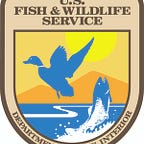Monumental Migrations for World Fish Migration Day!
Celebrate and experience the joys of fish passage with the “living laboratory” that is the Elwha Watershed!
By: Dan Spencer, Information & Education Specialist, Puget Sound & Olympic Peninsula Complex (USFWS)
Photo: Tagged steelhead on the Elwha River, Credit: Olympic National Park
If you free it, they will come! This Saturday, October 24 is World Fish Migration Day! And what better way to celebrate than to follow some history making journeys? The Puget Sound/Olympic Peninsula Fisheries Complex (U.S. Fish & Wildlife Service) is sharing a unique and engaging learning opportunity that features the world-famous Elwha River Restoration Project. Using real fish tracking data, participants plot and analyze the journeys of several fish throughout the watershed. Journeys that, until recently, had been blocked for close to 100 years.
Photo: A sample of the locations of steelhead and chinook salmon, Credit: FWS
The removal of Elwha and Glines Canyon dams on the mighty Elwha River of the Olympic Peninsula (WA) is the largest completed project of its kind. This historic achievement has also been the perfect opportunity to study the response of an ecosystem to dam removal. A large and diverse group of scientists from the Federal, State, and Tribal agencies as well as universities and conservation organizations have been studying many aspects of this living laboratory including: documenting the fish returns and movements; changes in the aquatic invertebrate communities; and changes in vegetation and animal populations on land.
Photo: Mobile tracking of lamprey on the Elwha River, Credit: Lower Elwha Klallam Tribe
The stars of this activity are Chinook Salmon, Steelhead, Bull Trout, and Pacific Lamprey. These species are all born in fresh water and migrate to salt water for part of their lives before returning to fresh water to reproduce. Since the removal of the two dams, biologists have captured several fish from each of these species and fitted them with radio tags. Each tag is like a mini radio station, transmitting a signal in a unique frequency and limited broadcast range. Like switching between radio stations in a car, biologists switch between frequencies using their receiver to pick up these sub-surface fish-infused “stations.”
Photo: Tagged Chinook salmon, Credit: Olympic National Park
Sometimes biologists were indeed switching between frequencies while riding (as passengers) up Olympic Hot Springs Road, for example. Other times, fish were tracked while hiking, via airplane, or while rafting down river. Not a bad way to spend your day at the “office”, eh?! Radio frequencies (individual fish) detected were documented along with their approximate location. There were also several “fixed stations” throughout the watershed, where computers connected to the receiver recorded the dates, times, and frequencies of tagged fish within range. Over the course of several months, the story of each tagged fish took shape, allowing biologist to determine if restoration goals have been achieved.
Biologist from the Olympic National Park and the Lower Elwha Klallam Tribe have generously provided the fish tracking data for this learning activity. Participants get a taste of fisheries biology work as they enter locations on Google’s free “My Maps” program, compare migrations within and between species, and form conclusions. In addition to biology and science careers, participants will also inherently learn about technology, math, and geography in the process. But the sky is the limit when it comes to how integrated the learning experience can be. Participants are also encouraged to delve deeper into the story of the Elwha Watershed, covering geology, history, Native American Studies, civics, and government, for example.
This curriculum is very flexible in nature; applicable to a range of grade levels (7th-12th) and subject coverage, allowing teachers and parents to mold it to the educational needs of their students. Yet this educational opportunity it is not limited to this age range or even to students. We encourage all curious minds to learn about this historic project as they follow some epic fish migrations. Happy tracking!
Please click here to access and download the curriculum pdf file.
